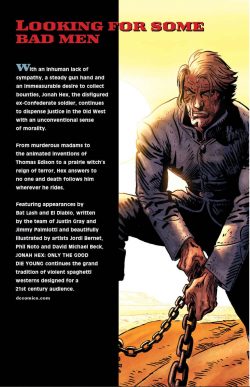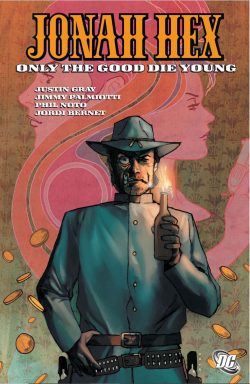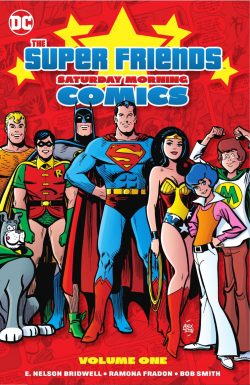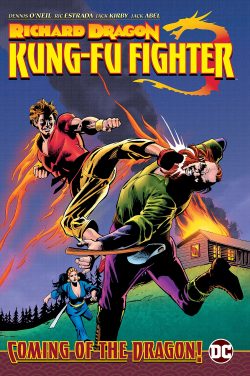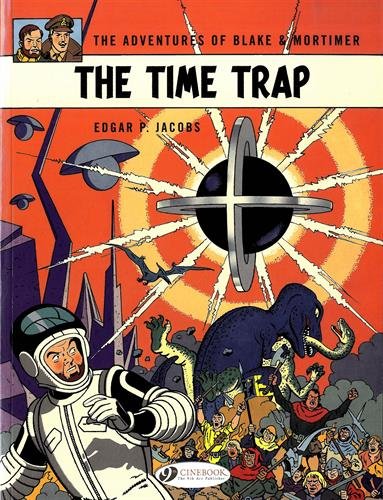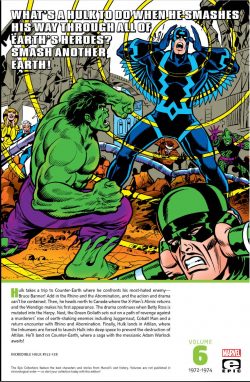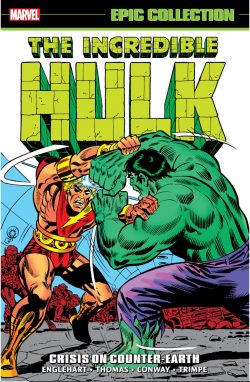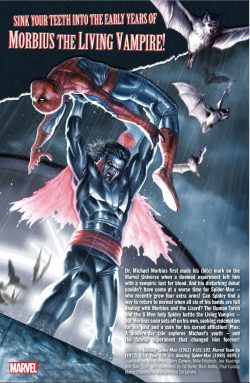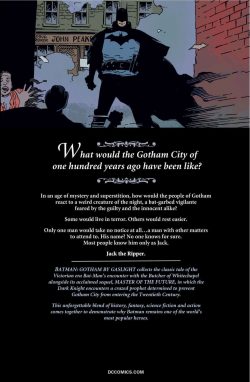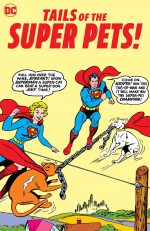

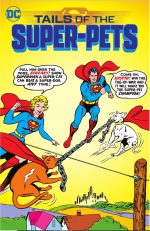
By Jerry Siegel, Robert Bernstein, Otto Binder, Leo Dorfman, Bill Finger, Edmond Hamilton, William Moulton Marston, Jim Shooter, Curt Swan, Jim Mooney, Pete Costanza, John Forte, Ramona Fradon, Sheldon Moldoff, George Papp, Harry G. Peter, Sy Barry, Stan Kaye, George Klein, Charles Paris & various (DC Comics)
ISBN: 978-1779513397 (TPB/Digital edition)
Once upon a time, comics embraced whimsy as much as angst, spectacle, sex and violence – so much so, that superheroes had pets for partners. Now there’s a movie about super-pets. You don’t have to like the notion, but plenty of us do.
Once upon another time, in the far future, a band of super-powered kids from dozens of alien civilisations took inspiration from the legend of the greatest champion of all time and formed a club of heroes. One day, those Children of Tomorrow came back in time and invited that legend to join them…
That’s how the tomorrow teen superstars started, courtesy of writer Otto Binder and artist Al Plastino in early 1958. The monumental assemblage’s popularity waxed and waned over decades and they were regularly reimagined and rebooted, but that core dream of empowered children was evergreen and proliferated. As their fame grew, the squad diversified, adding a Legion Espionage Squad, an evil Legion of Super-Villains, a Legion of Substitute Heroes ad infinitum…
DC had long exploited the attractions of bestial stars of fang and claw. Many Golden Age heroes had animal assistants and allies (like Dr. Mid-Nite‘s owl Hooty, Airwave‘s parrot Static and canine champions Elmo (Doll Man), and Thor (the Dan Richards Manhunter) among too many to mention. Streak the Wonder Dog actually ousted the original Green Lantern from his own comic book.
In the 1950s, Rex the Wonder Dog had his own long-running, astonishingly daft but beautifully illustrated title, with the majority of issues also featuring beloved hairy gumshoe Detective Chimp. Moreover, every newly-popular western star (and a few war heroes) who took the place of the declining superhero population had weaponised dogs, birds and especially horses to aid and augment their crusades for justice.
However, not all mystery men and women faded away. Wonder Woman and Batman and Robin weathered the hostile environment, and the Superman franchise grew exponentially -thanks to a hit movie, landmark TV series and continued radio and newspaper presence.
…And one day someone at National/DC said, “you what else kids like? Animals…â€
That led to a slow trickle of empowered animals popping up across the Kryptonian end of DC’s landscape, and a few other incidental animal antics in the lives of many superheroes who survived on the coattails of the “Trinity†– particularly Aquaman (who’s cruelly underrepresented here, since his whole schtick was underwater “stupid pet tricksâ€â€¦)
If you are a purist, there’s a lot you won’t like here – not the stories: those are still immaculately conceived and delivered, but the running order (not chronological, leading to some jarring moments, especially for Supergirl who seemingly goes from orphan to adopted back to the institution), and possibly the fact that – technically – many of the critters romping here were not in the actual Legion of Super-Pets (or in fact the forthcoming movie, which remakes the brilliant beasts into a “Leagueâ€). I guess that just means we can look forward to a 75-year Celebration archival edition just for Krypto in 2025….
Here Endeth the Lesson: let’s talk about fun now.
What we do have on offer today is a joyously bright and bold compendium of charming adventure and repercussion-free thrills comprising mad moments from Action Comics #261, 266, 277, 292, 293, Adventure Comics #210, 256, 293, 322, 364, Batman #125, Superboy #76, Superman #176 and Wonder Woman #23, spanning 1947-1968 and adorned where applicable with covers by Curt, Swan with Stan Kaye & George Klein and H.G. Peter.
I’ve rambled on and indulged myself because there’s no introduction or context-delivering text so you can start well-briefed with the truly delightful Supergirl short from Action Comics #277 (June 1961) Crafted by Jerry Siegel & Jim Mooney, ‘The Battle of the Super-Pets!’ finds her cat Streaky typically envious of attention the teenager pays to sneaky ingratiating mutt Krypto. When Superman suggests they compete for her attentions to prove who’s best (no, really!), they choose the most unlucky locale for their arena…
That’s followed by Siegel & Mooney’s debut tail (sorry, not sorry) from Action Comics #261 (February 1960) which introduces the homeless earth stray, revealing how Streaky becomes, at irregular intervals ‘Supergirl’s Super-Pet!’…
The next tale is where we should have started as Adventure Comics #210 (March 1955) introduces ‘The Super-Dog from Krypton!’
After the Man of Tomorrow had made his mark as Earth’s premier champion, his originators took a long look and reasoned that a very different tone could offer a fresh look. What would it be like for a fun-loving lad who could do literally anything?
The answer came as Jerry Siegel & Joe Shuster – after years of agitating the publisher – unleashed the concept of Superboy: fleshing out doomed Krypton, Kal-El‘s early years, foster parents and a childhood full of fun and incident. The experiment was a huge hit and the lad swiftly bounced into the lead slot of Adventure Comics and – in 1949 – his own title: living a life forever set 20 years behind his adult counterpart.
Encountering crooks, monsters, aliens, other super kids, school woes and the suspicions of girl-next-door Lana Lang, Superboy enjoyed an eventful, wonderful life which only got better in Adventure Comics #210 (March 1955), as Otto Binder, Swan & Sy Barry introduced a waywardly mischievous and dangerously playful canine companion who had survived Krypton’s doom due to a freak accident. Krypto had been Kal-El’s pet on Krypton and used by Jor-El in desperation as a test animal for the space rocket he was building.
The dog’s miraculous arrival on Earth after years heralded a wave of survivors from the dead world over the latter part of the decade: all making Superboy feel less lonely and unique. Every boy needs a dog…
One of those latter additions debuted in Superboy #76, (December 1958) wherein by Binder & George Papp introduced ‘The Super Monkey from Krypton!’: one of Jor-El’s lab animals who had escaped and hidden in the baby’s spaceship. Hey, the world was ending: who had time to police lab specimens?
Dubbed “Beppoâ€, the super-monkey spent months in Earth’s jungles before accidentally finding Smallville and making life uncomfortable for toddler Clark Kent…
Set after she had been adopted and become a public hero rather than clandestine secret weapon, Action Comics #292 and 293 (September & October 1963) saw Supergirl acquire a mysterious new animal accomplice in the first two chapters of a trilogy by Leo Dorfman & Mooney. The extended storyline began when the typical (albeit invulnerable) teen got a new “petâ€. ‘The Super-Steed of Steel!’ was a beautiful white horse who helped her stave off an alien invasion, but the creature had a bizarre and mysterious past, revealed in ‘The Secret Origin of Supergirl’s Super-Horse!’ as his being a magically transformed centaur from ancient Greece. Sadly, the resolution of this this tryptic (‘The Mutiny of Super-Horse’) is not included here…
Briefly digressing, what follows is a short saga of a non-powered animal marvel as Batman #125 (August 1959) details ‘The Secret Life of Bat-Hound!’ by Bill Finger, Sheldon Moldoff & Charles Paris. For no reason I could possibly speculate upon, Ace the Bat-Hound debuted in Batman #92 (June 1955), by Bill Finger, Sheldon Moldoff & Charles Paris: a distinctive German shepherd temporally adopted by Bruce Wayne when John Wilker (Ace’s owner) was abducted. A skilled tracker with distinctive facial markings, the pooch inserted himself into the case repeatedly, forcing the Dynamic Duo to mask him up whilst they sought his abducted master and foiled a criminal plot. Like Krypto, Ace reappeared intermittently until Wayne stopped borrowing him and just adopted the amazing mutt.
Here, the original creative team have Ace narrate how that adoption happened in ‘The Secret Life of Bat-Hound’ (Batman #125, August 1959), and include his crucial part in capturing the nefarious gold-obsessed Midas Gang…
William Moulton Marston & Harry G. Peter convey us to Princess Diana’s childhood as Wonder Woman #23 (June 1947) reveals – via home movies of her seventh birthday – how mighty space-hopping marsupials migrated to Paradise Island and changed Amazon battle tactics forever in ‘Wonder Woman and the Coming of the Kangas!’ after which Adventure Comics #256 (January 1959) details ‘The Ordeal of Aquaman’ as he is trapped in a desert and saved from dehydrating doom by his faithful octopus Topo in a smartly inventive yarn from Robert Bernstein & Ramona Fradon.
The Supergirl tale in Action Comics #266 (July 1960, by Siegel, & Mooney) sees ‘The World’s Mightiest Cat!’ Streaky inadvertently contribute to the isolation of an orphan boy with a reputation for tall tales before Krypto and the Maid of Might make everything right whilst Adventure Comics #293 (February 1962) delivers a gripping landmark thriller from Siegel, Swan & George Klein.
‘The Legion of Super-Traitors’ posits human Legionnaires abruptly turning evil, prompting Saturn Girl to recruit a Legion of Super-Pets comprising Krypto, Streaky, Beppo and Comet to save the world from mind-controlling alien brains in floating glass jars – and yes, I typed all that with a reasonably straight face…
After the human Legion won their own regular series, the animal brigade were ratified and rewarded with their own branch, and Adventure Comics #322 (July 1964, by Edmond Hamilton, John Forte & Moldoff) saw them expand their roster in ‘The Super-Tests of the Super-Pets!’: a sheer bonkers slice of fun-filled futurism wherein the animal companions were left to guard Earth as the biped players pursued the elusive Time Trapper.
When Chameleon Boy‘s shapeshifting (and fully sapient) pet Proty II applied to join the bestial bunch, they gave him a series of extremely difficult qualification tasks …which they breezed through…
A long-neglected tale follows as ‘The Revenge of the Super-Pets!’ (Superman #176, April 1965 by Dorfman, Swan & Klein) sees the a beast brood join the Human of Steel in a time travel jaunt that solves a legal mystery and explains how the growth of modern animal rights began!
Wrapping up with a more dramatic romp from Adventure Comics #364 (January 1968), ‘The Revolt of the Super-Pets!’ is by Jim Shooter & Pete Costanza: a gripping two-parter that depicts how the crafty rulers of planet Thanl attempted to seduce animal adventurers Krypto, Streaky, Beppo, Comet and amorphous telepathic blob Proty II from their rightful – subordinate – positions with sweet words and palatial new homes.
Of course, the aliens had a cunning scheme in play, but failed to realise these were not dumb animals…
Brilliantly reviving the beguiling innocence of the Silver Age for new, fun-seeking generations, this article of animalistic arcana is an unadulterated frolic to stir the elderly like me and enchant the newest DC disciples. Fetch!
© 1947, 1955, 1958, 1959, 1960, 1961, 1962, 1964, 1965, 1968, 2022 DC Comics. All Rights Reserved.

